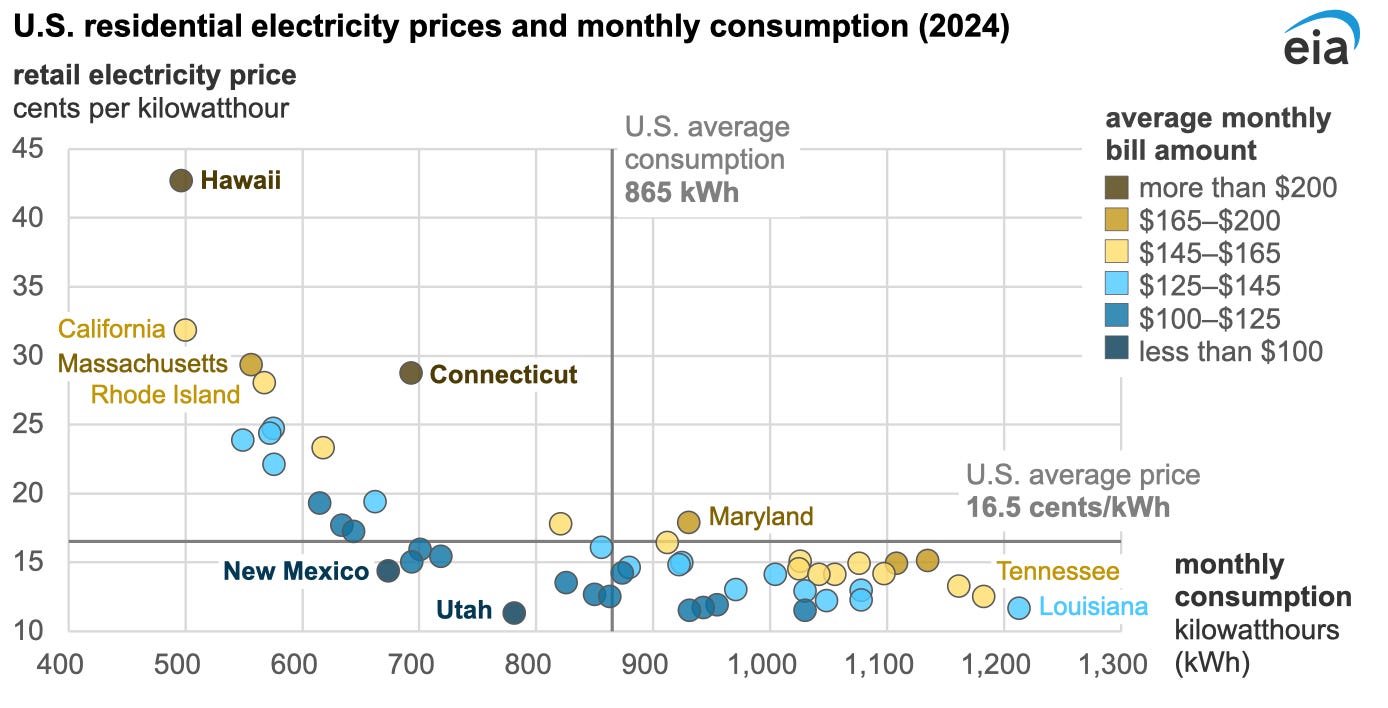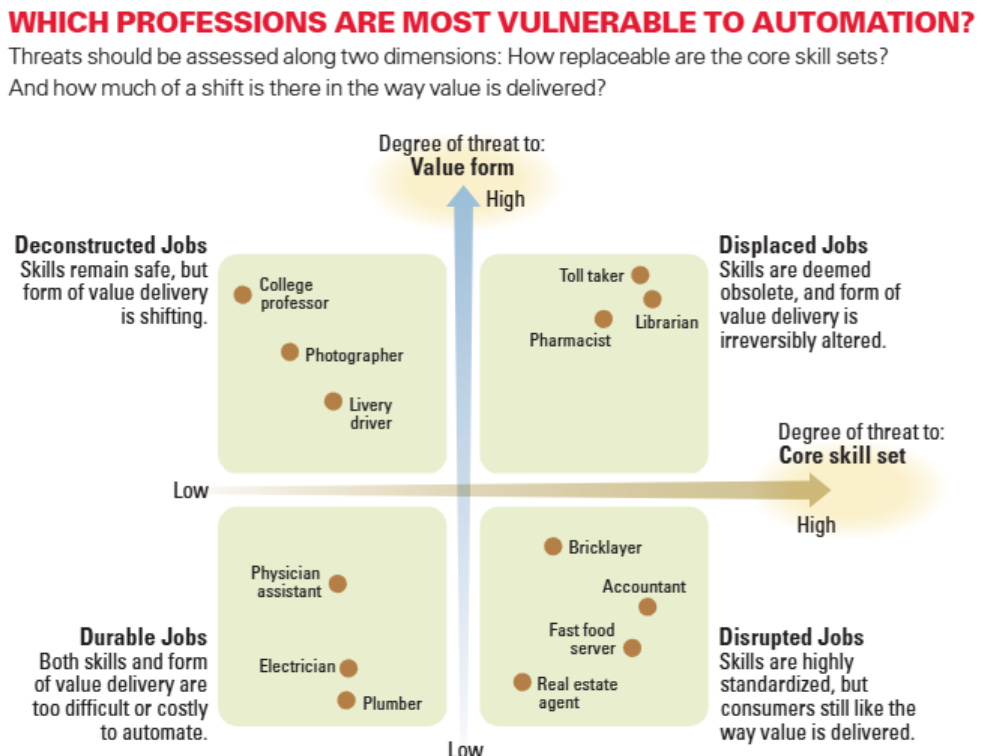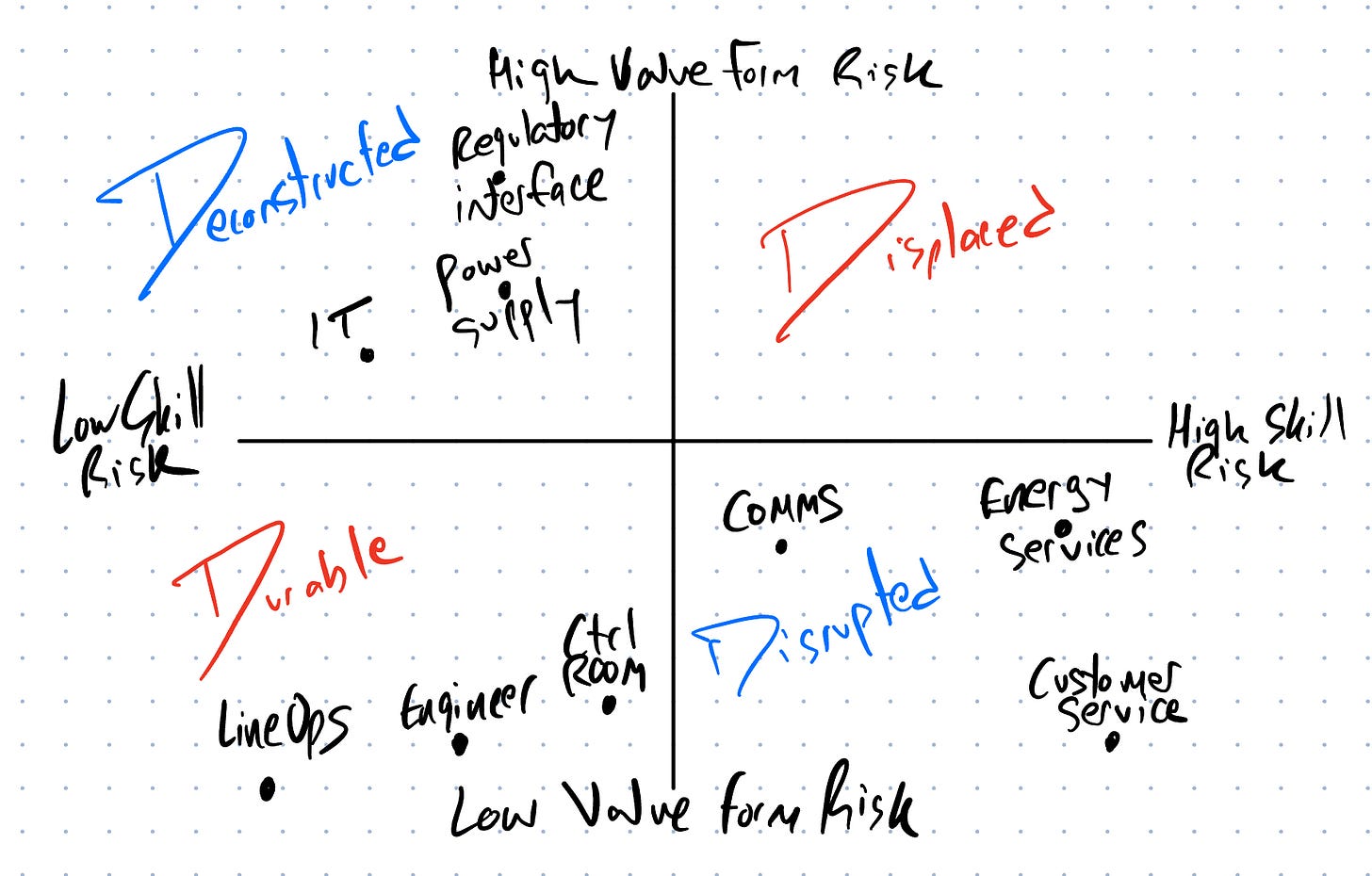AI in Electric Utilities is NGMI
Not. Going. To Make It.
Electric utilities have two points of interaction with the abrupt boom in generative AI technologies: AI as sudden new electric load, and AI as a tool for customer service, load forecasting, and regulatory interface. For New England, that former concern is effectively a non-issue, because our region has absurdly high electric rates in league with California:

Any compute that can be located outside of New England will be located outside of New England. If you’re using less than a million tokens per day, you don’t have latency or bandwidth issues that necessitate co-locating near a compute cluster. If you are, then you’re not building compute in New England; you’re instead moving your office to Ashburn, VA, where the compute already has been built. New England’s load growth will come from heating electrification1—everything else is peanuts in comparison.2
As for staffing changes, there is an angle: A 2018 MIT Sloan article describes four ways a job description can get shifted by automation. The underlying matrix tracks whether automation will change how the job is delivered and/or whether automation will displace the underlying skill sets:3
Displaced Jobs: Obsolete skills, obsoleted delivery of value. Cooked.
Deconstructed Jobs: The skills remain safe. An AI system can’t replace them in all contexts, but AI-generated products can replace the value borne out of those skills, at least in some contexts. In modern parlance, these jobs can be threatened by slop—AI-generated stock images, AI-generated code, AI-based tutoring services, AI-proctored cognitive behavioral therapy. The digital system cannot replicate a skilled photographer, software engineer, professor, or psychotherapist, but in many cases it does not have to.
Disrupted Jobs: The skills can be automated, but the underlying value underneath those jobs is still necessary. Customers may still prefer the human touch in some cases. These jobs are threatened not by slop but by AI-enhanced humans. Anyone in this job category can use AI tools to outperform their peers by at least 10x.
Durable Jobs: Immune to automation with current technology.
Within the electric utility, different jobs will be affected differently. Engineering and line-operations jobs are durable. Tesla’s Optimus cannot fix a car vs. pole outage. Much of the customer-facing jobs—customer service, communications, energy services, rebate processing—might face disruption. Many routine customer service tasks can be automated, but these divisions are typically so overloaded that automation would simply improve customer outcomes without serious job loss. Meanwhile, back-of-office jobs—IT, power supply, regulatory interface, my job—are more likely to be deconstructed. Claude is so good for untangling narratives in PUC dockets, and I dream of the day I can point a large language model at some of my Excel forecasts. Someone theoretically could displace Energy Crystals with an AI-enabled slop account blasting mid-tier energy analysis. It might even produce better output than CSIS! But my analysis and writing are better than an AI model’s output—and frankly if your work is not, that’s a skill issue.
But all that is moot
,4 because generative AI in electric utilities is not going to make it (ngmi).5Cybersecurity
Electric utility IT staff are a paranoid folk. Like all IT staff, they are acutely aware of all the ways that an attacker can infiltrate one’s software stack, most pressingly by duping any given staffer into handing over their password.6 However, electric utilities do not pay FAANG money, or even DoD money, meaning utility IT staff lack the time, budget, and personal ambition to fight fire with fire. Besides, there’s an easy way to protect yourself from a particular vector of cyberattack: don’t use the thing in the first place. For this reason, electric utility IT staff really like on-premise (on-prem) computing. Even if electric utilities run data-intensive meter data management systems (MDMS), we like keeping the server racks in-house, on an intranet, sequestered inside the office with a physical lock. Even cloud data is a sketchy proposition.
At a previous job, I pitched the IT Director on getting a “Team” version of a generative AI tool. I didn’t trust the default “Pro” version not to vacuum up confidential data I entered into the chat terminal, but I wanted to get a sense of whether the IT Director believed OpenAI and Anthropic when they said “we protect input data in our Team plans.” My IT Director did not trust OpenAI and Anthropic. Particularly, he said he would not trust the cybersecurity of generative AI systems until a software big dog like Microsoft or Oracle gave the all-clear. I, personally, don’t trust Microsoft or Oracle either, but maybe they’re easier targets for fat liability settlements.
Slow IT Adoption
Convincing the IT staff would only be the first step—even installing software is slow. Historically, installing (or updating) utility software like a customer information system (CIS) or outage management system (OMS) is an 18-24-month affair, for reasons beyond me. Municipal software is historically janky, partially because these projects are awarded to the lowest bidder, partially because our specs-by-committee RFPs ask for solutions so particular and pricing structures so byzantine that making fat margins are nigh-impossible anyway.
New England, in particular, has been talking about AMI deployment for more than a decade, and we’re still not fully-networked, much less stocked with the software chops to do anything consequential with the data. Our rate structures certainly have not changed. We still have not made demand response programs that aren’t crap. The South, interestingly, is faster on this tech deployment. However, from the anecdotes I’ve heard about the lengths Southern customers will go to avoid paying their electric bill, I suspect the cost-benefit for remote-disconnect electric meters that phone home when tampered is…higher.
Weak-to-Nonexistent Data Strategies
Should an AI tool be installed on utility’s machines, it will come face-to-face against a poor data strategy. How should a chatbot speak to a utility customer? What information is relevant for a ten-year load forecast? Are there any patterns in usage that we haven’t seen yet?
A generative AI system can handle a lot of these tasks, but the AI requires input data to do anything. Garbage In, Garbage Out (GIGO) is one thing, but electric utilities are Nothing In, Nothing Out organizations. Our quantitative analysis is almost all Excel. Python and R are toolsets for newcomers. A utility may have a SQL server, but under 5% of the staff has the baseline SQL chops to use pre-written queries, much less write their own. Documentation for any software tools are years out of date if ever written. File management is a nightmare. Leadership in particular do not know how to access their own data outside of precooked dashboards, and they typically do not talk about data strategy in a manner that suggests they know what a database is. And fixing these problems will prove challenging. At my workplace, key swaths of the business are propped by years-old compiled software with no record of the original code. At my previous job, one person knew the metering database well enough to extract billing determinants.
This Will Not Get Fixed Anytime Soon
Electric utilities are, as a general rule, about a decade behind the ball on information technology. And we’re too sclerotic in organization and culture to keep up. We might see some progress as aging staff and leadership cohorts retire, but there aren’t enough young people (as in under-40) to fill seats, meaning even the fresh IT hires are too understaffed and overloaded to do more than put out fires.
Outside of individual staffers with ChatGPT windows paid from their own money, electric utilities will not pick up access to generative AI until utility-facing vendors like Siemens, ABB, Schneider Electric, and Itron fold them into software. Maybe in five years, the next version of Cogsdale or NorthStar will include a “Customer Summary” tool built on a generative AI system. Maybe Microsoft will finally bundle Copilot into Microsoft Excel. But I’ve also been waiting five-plus years for a functional EV charger platform that isn’t Tesla,7 for a SharePoint file structure more intuitive than ten-years-ago Google Docs, and for a distributed energy resources management system (DERMS) that won’t drive me to drink. And none of those have happened.
Electric utilities aren’t even sold on The Cloud as a viable computing strategy. Some in the old guard barely know how to operate Microsoft Teams. By the time we shamble into adoption of generative AI, the hard problems will have been solved already, in other industries, by brighter minds.
Great for me and my job security. Not great for utility customers.
This post and the information presented are intended for informational purposes only. The views expressed herein are the author’s alone and do not reflect those of their current or previous employers or any elected officials. The author makes no recommendations toward any electric utility, regulatory body, or other organization. While certain information contained herein has been obtained from sources believed to be reliable, the author has not independently verified this information, and its accuracy and completeness cannot be guaranteed. Accordingly, no representation or warranty, express or implied, is made as to, and no reliance should be placed on, the fairness, accuracy, timeliness or completeness of this information. The author assumes no liability for this information and no obligation to update the information or analysis contained herein in the future.
That’s electric heat pumps and electric water heaters. Electric vehicles will add electric usage, but they’re flexible enough to cause fewer problems for the grid.
Texas, by contrast, has problems incoming, per SemiAnalysis.
This article, of course, is pre-ChatGPT. I disagree with some of its examples, but the underlying idea is solid.
“NGMI” and its converse “WAGMI” (We’re All Going to Make It), like a concerning proportion of my vocabulary, started on 4chan—particularly, the /fit/ and /biz/ boards. I picked up the term by way of r/WallStreetBets, because Reddit is the primary launderer of 4chan culture.
Tesla is uniformly miserable to work with—apparently they don’t pick up your phone calls until you have a million-dollar-plus account with them.







Good insight. Software, AI, tech etc can only help if the input is there. Its not magic. That being said, here's a fun thought experiment. Imagine the bizzarro dimension where the industry was ready, now. What would that look like? on a day to day, ground level view, what does it look like? Now work backward to how you got there.